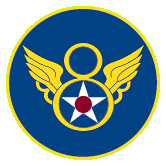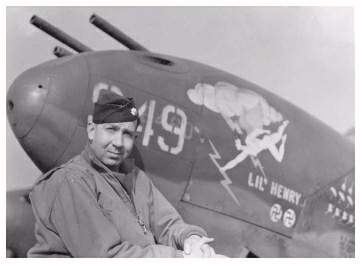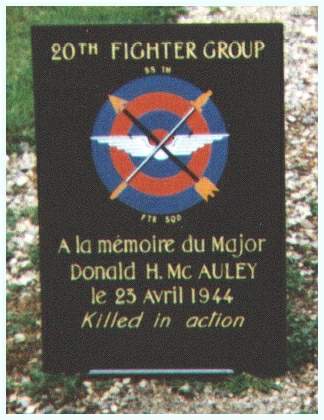|
 "A TRIBUTE TO 'MAC'"
"A TRIBUTE TO 'MAC'"
By: David G. Knight
 � � �� � In times of war a nation's need for men at arms throws many people of differing backgrounds and professions together. Many pay the supreme sacrifice whilst the majority serve the duration in complete anonymity returning to their homes to pick up the threads of a normal life - if life can be normal again. Others are destined, through various reasons, to find fame in the great adventure of the young man's vision of war. Individuals by their actions quickly come to the fore as leaders of men: some by their individuality; others by their caring methodical and rational approach to the job in hand. Into this second category fell Major Donald H. McAuley, who would have undoubtedly risen to high rank in the airforce had he not met an untimely death in action on April 23rd 1944. At this time many who knew him considered him already fitted to command a fighter group in front line action.
� � �� � In times of war a nation's need for men at arms throws many people of differing backgrounds and professions together. Many pay the supreme sacrifice whilst the majority serve the duration in complete anonymity returning to their homes to pick up the threads of a normal life - if life can be normal again. Others are destined, through various reasons, to find fame in the great adventure of the young man's vision of war. Individuals by their actions quickly come to the fore as leaders of men: some by their individuality; others by their caring methodical and rational approach to the job in hand. Into this second category fell Major Donald H. McAuley, who would have undoubtedly risen to high rank in the airforce had he not met an untimely death in action on April 23rd 1944. At this time many who knew him considered him already fitted to command a fighter group in front line action.McAuley was commissioned 2nd Lt. in the A.A.F. at Luke Field, Phoenix, Arizona on November 1st 1941. Initially he did not receive fighter pilot training, being retained at Luke Field as an instructor assigned to train Chinese Air Force pilots. Although idolised by the Chinese "Mac" soon realised they had no concept of anything mechanical. If he called for right or left rudder when they were about to ground loop then they would push the rudder all the way and ground loop in the opposite direction! After 14 months of these "experiences" he decided it was safer outside Training Command and was released to train as a combat pilot joining the 55th Fighter Squadron of the 20th Fighter Group at March Field, California on January 25th 1943. On the squadron he was quickly recognised as an aggressive pilot and leader. These qualities being rewarded with promotion to 1st Lt. on March 19th. Further responsibility came in April when he was appointed "B" Flight Commander - a position in which pilots looked up to him for guidance and advice. With the 20th Fighter Group's assignment to the 8th Air Force in England, in August 1943, the 55th Fighter Squadron was stationed at R.A.F. Wittering a few miles from its associate squadrons at King's Cliffe. In October 1943, "Mac" was promoted Capt. and took over as Squadron Ops., Officer on November 24th, doing much to sustain the physical conditioning and morale of pilots and enlisted men in the build-up to operations. Commencing in November 1943, the 20th's squadrons flew individual combat missions with the 55th Fighter Group based at Nuthampsted, McAuley flying his first mission with the 77th Squadron to Solingen on December 1st. When the 20th flew its first full operation on December 28th he was at the fore, leading the 55th Squadron.
"Mac" remained 55th Ops., Officer until March 1944, proving himself a cool, deliberate leader in the air and on the ground. Royal Frey, then a young 2nd Lt. looked on him as a "father figure" and further comments: I considered him a real fine type: calm, quiet and completely compassionate. For instance when Fiebelkorn "goofed" three times "Mac" felt like a dog transferring him to H.Q. but felt it was necessary for all of us from a survival angle." The early days of 1944 were trying times, with long missions at high altitude. McAuley was constantly working with the ground crews on modifications to improve the reliability of the P-38. Every enlisted man regardless of where he worked looked up to him for his efforts. Major McGovern, 55th C.O. was transferred in December 1943 and McAuley became acting C.O. until Major Frank Clark took over. He in turn was transferred and on March 8th 1944 McAuley was promoted Major and a wave of enthusiasm ran through the 55th as he became squadron commander; morale was at its peak. As C.O. McAuley flew almost ever mission, alternating with Capt. McLary (then Ops., Officer). He always made a point of leading the toughest missions. Missions which took him to Ludwigshaven, Frankfurt, Brunswick, Wilhelmshaven, Schweinfurt and, on March 6th, Berlin. The fateful mission of April 23rd, called for a double "Droopsnoot" strike at the French airfields of Tours and Chateaudun. After bombing Tours the group flew to Chateaudun and proceeded to bomb the airfield. This was followed by a strafing run by the P-38s, which had bombed Tours. According to Major Franklin (79th Sqdn) who led the strafing: "Ground fire was intense and it would be inadvisable to strafe the field again unless it had been subjected to an attack by heavy bombers." It was during this strafing pass that two 55th Squadron aircraft were hit: one flown by Lt. Ahern, the other McAuley's P-38 named "Li'l Henry". Here something of a mystery arises. Returning pilots stated that they had seen "Mac" bail out and he waved as he floated down. His dinghy, having been knocked open, floated down with him. However, the German account of McAuley's death states he died of wounds received in the shooting down. Could it be he was killed by stray ground fire as he floated down over the airfield? Whatever happened was a tragedy for the 55th. That evening silence descended over the Squadron. Matt Cicero, then Squadron Exec., recalls the feelings: "Everybody felt the tremendous loss. Personally I was a very emotionally subjected person and proceeded to get absolutely drunk, smashing my beer glass against the wall in utter frustration at the loss of such a fine officer and friend." McAuley flew 57operational sorties with the 20th Group and was awarded the Air Medal with Oak Leaf Cluster. He claimed one Me109 and an FW190 destroyed and a FW190 as probable. Two P-38s were assigned to him in the 55th Squadron: P-38J10-LO 42-67657 KI-A and P-38J-10-LO 42-67949 KI-A "Li'l Henry". Today he lies at rest in the military cemetery at Epinal, France. It is perhaps fitting that one of the people he cared about most, the enlisted man, should have the final words on McAuley's influence on the 20th Fighter Group's proud traditions and history. Gene West, a former T/Sgt in the 55th Squadron, recalls: "I knew more of him than most other enlisted men since I worked closely with him when he was Operations Officer and C.O. He was a very level-headed individual who cared about his men: quiet, assured, considerate and a person in whom a man could confide. In short a man to whom arrogance, ego and the "cavalier attitude" of many pilots were unknown. If one person deserved to survive the war it was Major Donald H. McAuley." Author would like to thank Matt Cicero, Gene West and Royal Frey for their help with this article. Copyright: David G. Knight, England 1986
|

